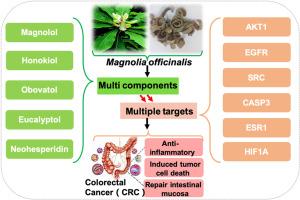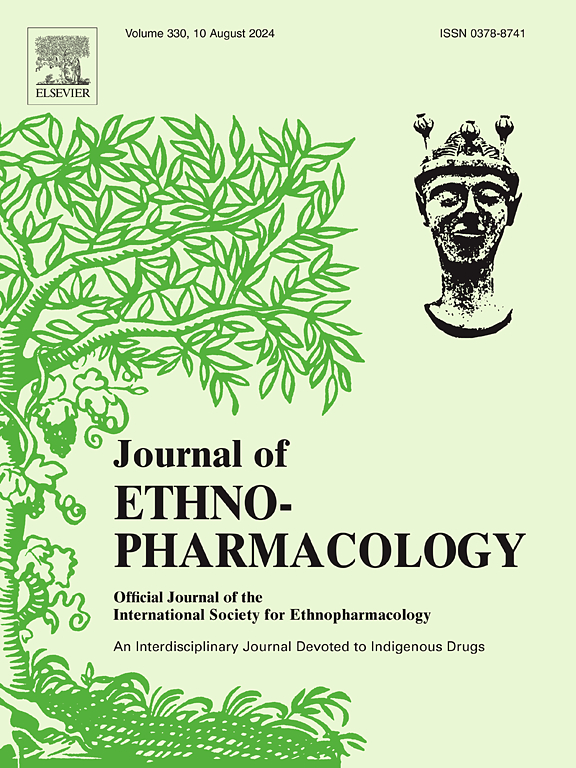厚朴对结直肠癌的作用和机制:多成分多靶点方法
IF 5.4
2区 医学
Q1 CHEMISTRY, MEDICINAL
引用次数: 0
摘要
民族药理学意义:结直肠癌(CRC)是一种常见的消化道恶性肿瘤。中医药治疗 CRC 具有历史悠久、疗效显著、多靶点、多途径、副作用小等优势。中药厚朴(M. officinalis)是指厚朴(Magnolia officinalis Rehd.et Wils.)或厚朴(Magnolia officinalis Rehd.et Wils.)变种(Magnolia officinalis Rehd.et Wils.var.biloba Rehd.et Wils.)的干燥树皮、根皮和枝皮。由于具有抗炎和抗肿瘤的特性,它通常被用来减轻 CRC 化疗的副作用。然而,目前的研究主要集中在单个成分上,并没有考虑到多成分多靶点作用的特点:我们的目的是研究 M. officinalis 在治疗 CRC 方面的新作用特征:利用网络药理学确定了M. officinalis治疗CRC的潜在活性成分、关键靶点和主要信号通路。通过分子对接分析进一步验证了其结合效果。此外,还利用液相色谱-质谱法(LC-MS)鉴定了上述成分,并分析了主要成分的裂解途径。随后,进行了体外和体内实验,以研究M. officinalis有效成分的抗CRC作用及其潜在机制:结果:通过网络药理学和分子对接,确定了M. officinalis治疗CRC的5种主要活性成分和6个核心靶点。然后,LC-MS鉴定了M.同时,体外和体内实验都证实了桉叶油醇(Euc)和奥博瓦醇(Obo)具有抑制炎症和肿瘤细胞增殖的能力。其中的可能机制是,桉叶油醇和奥波分别通过抑制 NF-κBp65/JAK 和 Bcl-2/Caspase 信号通路的过度激活来对抗 CRC。结论结论:M.officinalis中的Magnolol(MAG)、Honokiol(HK)、Euc、Obo和Neohesperidin(NHP)可能是其对CRC具有抗癌作用的药理基础。当归对 CRC 的治疗具有多成分、多靶点、多途径的特点。这些发现为进一步启发欧当归的临床应用和疗效靶点的开发提供了理论依据。本文章由计算机程序翻译,如有差异,请以英文原文为准。

Effect and mechanism of Magnolia officinalis in colorectal cancer: Multi-component-multi-target approach
Ethnopharmacological relevance
Colorectal cancer (CRC) is a prevalent malignant tumor of the digestive tract. Traditional Chinese medicine (TCM) has a long history of treating CRC, with advantages such as effectiveness, multi-target, multi-pathway, and minimal side effects. TCM Magnolia officinalis (M. officinalis) refers to the dried bark, root bark, and branch bark of either Magnolia officinalis Rehd.et Wils. or Magnolia officinalis Rehd.et Wils. var. biloba Rehd.et Wils. It is commonly utilized to alleviate the side effects of chemotherapy for CRC, owing to its anti-inflammatory and anti-tumor properties. However, current research primarily focuses on the individual components and does not take into consideration the characteristics of multi-component-multi-target action.
Aim of the study
Our aim is to study the new action characteristics of M. officinalis in the treatment of CRC.
Materials and methods
Utilizing network pharmacology to identify potential active ingredients, key targets, and main signaling pathways of M. officinalis for the treatment of CRC. The binding effect was further validated through molecular docking analysis. Furthermore, the aforementioned components were identified using liquid chromatography-mass spectrometry (LC-MS), and the cleavage pathways of the main components were analyzed. Subsequently, both in vitro and in vivo experiments were carried out to investigate the anti-CRC effect of the active ingredients of M. officinalis and its potential mechanism.
Results
Network pharmacology and Molecular docking identified 5 main active ingredients and 6 core targets of M. officinalis for the treatment of CRC. Then, LC-MS identified the active components of M. officinalis. At the same time, both in vitro and in vivo experiments have confirmed the ability of Eucalyptol (Euc) and Obovatol (Obo)to inhibit inflammation and tumor cell proliferation. The possible mechanism involved is that Euc and Obo counteract CRC by inhibiting the over-activation of NF-κBp65/JAK and Bcl-2/Caspase signaling pathways, respectively. They also play a role in the anti-CRC effect of M. officinalis.
Conclusion
Magnolol (MAG), Honokiol (HK), Euc, Obo, and Neohesperidin (NHP) in M. officinalis may be the pharmacological substance basis for its anti-cancer effect on CRC. The treatment of CRC with M. officinalis is characterized by its multi-component, multi-target, and multi-pathway approach. These findings provide a theoretical basis for further inspiring the clinical application of M. officinalis and the development of efficacy targets.
求助全文
通过发布文献求助,成功后即可免费获取论文全文。
去求助
来源期刊

Journal of ethnopharmacology
医学-全科医学与补充医学
CiteScore
10.30
自引率
5.60%
发文量
967
审稿时长
77 days
期刊介绍:
The Journal of Ethnopharmacology is dedicated to the exchange of information and understandings about people''s use of plants, fungi, animals, microorganisms and minerals and their biological and pharmacological effects based on the principles established through international conventions. Early people confronted with illness and disease, discovered a wealth of useful therapeutic agents in the plant and animal kingdoms. The empirical knowledge of these medicinal substances and their toxic potential was passed on by oral tradition and sometimes recorded in herbals and other texts on materia medica. Many valuable drugs of today (e.g., atropine, ephedrine, tubocurarine, digoxin, reserpine) came into use through the study of indigenous remedies. Chemists continue to use plant-derived drugs (e.g., morphine, taxol, physostigmine, quinidine, emetine) as prototypes in their attempts to develop more effective and less toxic medicinals.
 求助内容:
求助内容: 应助结果提醒方式:
应助结果提醒方式:


